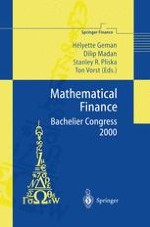2002 | OriginalPaper | Buchkapitel
Default Risk and Hazard Process
verfasst von : Monique Jeanblanc, Marek Rutkowski
Erschienen in: Mathematical Finance — Bachelier Congress 2000
Verlag: Springer Berlin Heidelberg
Enthalten in: Professional Book Archive
Aktivieren Sie unsere intelligente Suche, um passende Fachinhalte oder Patente zu finden.
Wählen Sie Textabschnitte aus um mit Künstlicher Intelligenz passenden Patente zu finden. powered by
Markieren Sie Textabschnitte, um KI-gestützt weitere passende Inhalte zu finden. powered by
The so-called intensity-based approach to the modelling and valuation of de-faultable securities has attracted a considerable attention of both practitioners and academics in recent years; to mention a few papers in this vein: Duffie [8], Duffie and Lando [9], Duffie et al. [10], Jarrow and Turnbull [13], Jarrow et al. [14], Jarrow and Yu [15], Lando [21], Madan and Unal [23]. In the context of financial modelling, there was also a renewed interest in the detailed analysis of the properties of random times; we refer to the recent papers by Elliott et al. [12] and Kusuoka [20] in this regard. In fact, the systematic study of stopping times and the associated enlargements of filtrations, motivated by a purely mathematical interest, was initiated in the 1970s by the French school, including: Brémaud and Yor [4], Dellacherie [5], Dellacherie and Meyer [7], Jeulin [16], and Jeulin and Yor [17]. On the other hand, the classic concept of the intensity (or the hazard rate) of a random time was also studied in some detail in the context of the theory of Cox processes, as well as in relation to the theory of martingales. The interested reader may consult, in particular, the monograph by Last and Brandt [22] for the former approach, and by Brémaud [3] for the latter. It seems to us that no single comprehensive source focused on the issues related to default risk modelling is available to financial researchers, though. Furthermore, it is worth noting that some challenging mathematical problems associated with the modelling of default risk remain still open. The aim of this text is thus to fill the gap by furnishing a relatively concise and self-contained exposition of the most relevant — from the viewpoint of financial modelling — results related to the analysis of random times and their filtrations. We also present some recent developments and we indicate the directions for a further research. Due to the limited space, the proofs of some results were omitted; a full version of the working paper [19] is available from the authors upon request.
